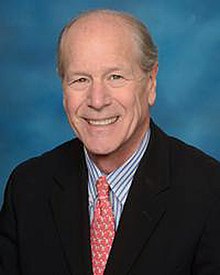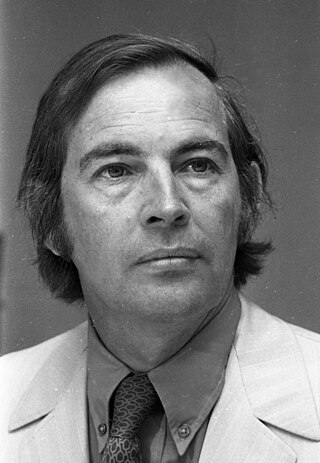
Christiaan Neethling Barnard was a South African cardiac surgeon who performed the world's first human-to-human heart transplant operation. On 3 December 1967, Barnard transplanted the heart of accident victim Denise Darvall into the chest of 54-year-old Louis Washkansky who regained full consciousness and was able to talk easily with his wife, before dying eighteen days later of pneumonia, largely brought on by the anti-rejection drugs that suppressed his immune system. Barnard had told Mr. and Mrs. Washkansky that the operation had an 80% chance of success, an assessment which has been criticised as misleading. Barnard's second transplant patient, Philip Blaiberg, whose operation was performed at the beginning of 1968, returned home from the hospital and lived for a year and a half.

William Castle DeVries is an American cardiothoracic surgeon, mainly known for the first transplant of a TAH using the Jarvik-7 model.
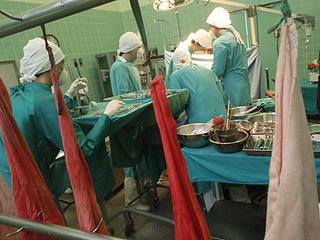
Organ transplantation is a medical procedure in which an organ is removed from one body and placed in the body of a recipient, to replace a damaged or missing organ. The donor and recipient may be at the same location, or organs may be transported from a donor site to another location. Organs and/or tissues that are transplanted within the same person's body are called autografts. Transplants that are recently performed between two subjects of the same species are called allografts. Allografts can either be from a living or cadaveric source.

Xenotransplantation, or heterologous transplant, is the transplantation of living cells, tissues or organs from one species to another. Such cells, tissues or organs are called xenografts or xenotransplants. It is contrasted with allotransplantation, syngeneic transplantation or isotransplantation and autotransplantation. Xenotransplantation is an artificial method of creating an animal-human chimera, that is, a human with a subset of animal cells. In contrast, an individual where each cell contains genetic material from a human and an animal is called a human–animal hybrid.

Dow Medical College is a public medical school located in the city of Karachi, Sindh, Pakistan. It was founded in 1945 and named after British civil servant Sir Hugh Dow, Governor of Sindh.
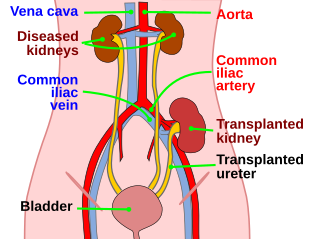
Kidney transplant or renal transplant is the organ transplant of a kidney into a patient with end-stage kidney disease (ESRD). Kidney transplant is typically classified as deceased-donor or living-donor transplantation depending on the source of the donor organ. Living-donor kidney transplants are further characterized as genetically related (living-related) or non-related (living-unrelated) transplants, depending on whether a biological relationship exists between the donor and recipient. The first successful kidney transplant was performed in 1954 by a team including Joseph Murray, the recipient’s surgeon, and Hartwell Harrison, surgeon for the donor. Murray was awarded a Nobel Prize in Physiology or Medicine in 1990 for this and other work. In 2018, an estimated 95,479 kidney transplants were performed worldwide, 36% of which came from living donors.

The University of Alabama at Birmingham Marnix E. Heersink School of Medicine is a public medical school located in Birmingham, Alabama, United States with branch campuses in Huntsville, Montgomery, and at the University of Alabama College of Community Health Sciences in Tuscaloosa. Residency programs are also located in Selma, Huntsville, and Montgomery. It is part of the University of Alabama at Birmingham (UAB).

NYU Langone Health is an academic medical center located in New York City, New York, United States. The organization consists of the NYU Grossman School of Medicine and NYU Grossman Long Island School of Medicine, both part of New York University (NYU), and more than 300 locations throughout the New York metropolitan area, including six inpatient facilities: Tisch Hospital; Kimmel Pavilion; NYU Langone Orthopedic Hospital; Hassenfeld Children's Hospital; NYU Langone Hospital – Brooklyn; and NYU Langone Hospital – Long Island. It is also home to Rusk Rehabilitation. NYU Langone Health is one of the largest healthcare systems in the Northeast, with more than 46,000 employees.
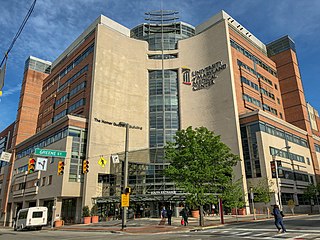
The University of Maryland Medical Center (UMMC) is a teaching hospital with 806 beds based in Baltimore, Maryland, that provides the full range of health care to people throughout Maryland and the Mid-Atlantic region. It gets more than 26,000 inpatient admissions and 284,000 outpatient visits each year. UMMC has approximately 9,050 employees at the UMMC Downtown Campus, as well as 1,300 attending physicians and 950 resident physicians across the Downtown and the Midtown campuses. UMMC provides training for about half of Maryland's physicians and other health care professionals. All members of the medical staff are on the faculty of the University of Maryland School of Medicine.
Transplantable organs and tissues may refer to both organs and tissues that are relatively often transplanted, as well as organs and tissues which are relatively seldom transplanted. In addition to this it may also refer to possible-transplants which are still in the experimental stage.

Stephanie Fae Beauclair, better known as Baby Fae, was an American infant born in 1984 with hypoplastic left heart syndrome. She became the first infant subject of a xenotransplant procedure and first successful infant heart transplant, receiving the heart of a baboon. Though she died within a month of the procedure, she lived weeks longer than any previous recipient of a non-human heart.

Miniature Pigs, also called mini pig are small breeds of domestic pig. Terms like “teacup,” “micro-mini,” and “nano-pig” are advertising, not real breeds. There are two types of mini pig: small traditional pig breed like the Vietnamese Pot-Bellied pig and smaller breeds like Göttingen minipig.

A heart transplant, or a cardiac transplant, is a surgical transplant procedure performed on patients with end-stage heart failure or severe coronary artery disease when other medical or surgical treatments have failed. As of 2018, the most common procedure is to take a functioning heart, with or without both lungs, from a recently deceased organ donor and implant it into the patient. The patient's own heart is either removed and replaced with the donor heart or, much less commonly, the recipient's diseased heart is left in place to support the donor heart.

United Therapeutics Corporation is an American publicly traded biotechnology company and public benefit corporation listed on the NASDAQ under the symbol UTHR. It develops novel, life-extending technologies for patients in the areas of lung disease and organ manufacturing. United Therapeutics is co-headquartered in Silver Spring, Maryland and Research Triangle Park, North Carolina, with additional facilities in Magog and Bromont, Quebec; Melbourne and Jacksonville, Florida; Blacksburg, Virginia; and Manchester, New Hampshire.
Robert Montgomery is the director of the Transplant Institute at NYU Langone Health.
Bernhard J. Hering is professor of surgery and medicine and executive director of the Schulze Diabetes Institute at the University of Minnesota, where he serves as Vice Chair of Translational Medicine in the Medical School's Department of Surgery and where he holds the McKnight Presidential Chair in Transplantation Science and the Jeffrey Dobbs and David Sutherland, MD, PhD Chair in Diabetes Research.
Xenotransfusion, a form of xenotransplantation, was initially defined as the transfer of blood from one species into the veins of another. In most cases, it is a transfer of blood between a non-human animal and a human. However, further experimentation has been done between various non-human animal species. This procedure can be performed without affecting the health of the donor, as only about 10% of their blood volume is used each time. Utilizing the unlimited blood supply from animal sources eliminates the risk of transmitting infectious diseases between humans.

Bruno Reichart is a retired German cardiothoracic surgeon who performed Germany's first successful heart transplant in 1981 and its first combined heart–lung transplant in 1983.

Keith Reemtsma was an American transplant surgeon, best known for the cross-species kidney transplantation operation from chimpanzee to human in 1964. With only the early immunosuppressants and no long-term dialysis, the female recipient survived nine months, long enough to return to work.
Dhaniram Baruah is an Assamese heart surgeon known for his work in the field of xenotransplantation. He is popularly known as India's Pig Heart Doctor. On 1 January 1997, he became the first heart surgeon in the world to transplant a pig's heart in a human body. Although the recipient died subsequently, it was a precursor to the first successful pig-to-human heart transplant performed 25 years later by Bartley P. Griffith in January 2022. While Griffith used a genetically modified pig's heart, Barua had transplanted a normal pig heart. Barua is also the founder of Dr Dhaniram Baruah Heart Institute & Research Centre. He can only communicate through hand gestures after a brain stroke left him unable to speak.
